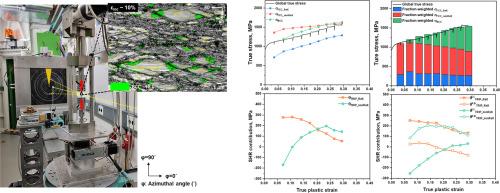部分再结晶亚稳中熵合金的复杂变形行为:原位同步加速器x射线衍射研究
IF 8.3
1区 材料科学
Q1 MATERIALS SCIENCE, MULTIDISCIPLINARY
引用次数: 0
摘要
亚铁中熵合金(femea)利用变形诱发马氏体相变(DIMT)表现出优异的应变硬化能力,这是由于相变诱发塑性(TRIP)效应。为了提高低屈服强度,采用局部再结晶控制初始组织。复杂的初始微观结构是再结晶(ReX)和非再结晶(non-ReX)区域的混合,导致复杂的变形行为,其中ReX和非ReX区域的DIMT同时被激活,这给分析带来了重大挑战。在本文中,我们对部分再结晶亚稳态Fe57.5Co18Cr13Ni7.5Mo3C1 (at%) FeMEA进行了原位同步x射线衍射,定量分析了每种变形机制。峰值反褶积的创新思想使ReX和非ReX FCC域的变形行为能够分开跟踪,揭示它们之间的应力划分。通过区域分数的演化研究了每个区域的DIMT动力学,并详细讨论了它们如何表现出快速的DIMT动力学。此外,我们还测量了在每个区域发生的DIMT对整体应变硬化速率的贡献。结果表明,随着变形的进行,主要的贡献从ReX域的DIMT转移到非ReX域的DIMT,突出了ReX和非ReX域之间独特的应变硬化机制。这项工作证明了部分再结晶亚稳态FeMEA如何表现出优越的力学性能,并为分析复杂的变形行为提供了见解。本文章由计算机程序翻译,如有差异,请以英文原文为准。


Complex deformation behavior of a partially recrystallized metastable medium-entropy alloy: In-situ synchrotron X-ray diffraction study
Ferrous medium-entropy alloys (FeMEAs), leveraging deformation-induced martensitic transformation (DIMT), demonstrate excellent strain-hardening ability attributed to the transformation-induced plasticity (TRIP) effect. To improve the low yield strength of FeMEAs, the initial microstructure was controlled by utilizing partial recrystallization. The intricate initial microstructure, a blend of recrystallized (ReX) and non-recrystallized (non-ReX) regions, results in complex deformation behavior where DIMT in both the ReX and non-ReX regions are simultaneously activated, posing significant analytical challenges. In this paper, we perform in-situ synchrotron X-ray diffraction during the tensile loading on a partially recrystallized metastable Fe57.5Co18Cr13Ni7.5Mo3C1 (at%) FeMEA to quantitatively analyze each deformation mechanism. The innovative idea of peak deconvolution enables separate tracing of the deformation behavior of the ReX and non-ReX FCC domains, revealing the stress partitioning between them. DIMT kinetics in each domain are investigated by the evolution of domain fractions, and we provide a detailed discussion on how both of them exhibit rapid DIMT kinetics. Furthermore, we measure the contributions of DIMT occurring in each domain on the global strain-hardening rate. The results suggest that the predominant contribution shifts from DIMT in the ReX domain to DIMT in the non-ReX domain as deformation progresses, highlighting the distinctive strain-hardening mechanisms between the ReX and non-ReX domains. This work demonstrates how a partially recrystallized metastable FeMEA exhibits superior mechanical properties and provides insights into analyzing the complex deformation behavior.
求助全文
通过发布文献求助,成功后即可免费获取论文全文。
去求助
来源期刊

Acta Materialia
工程技术-材料科学:综合
CiteScore
16.10
自引率
8.50%
发文量
801
审稿时长
53 days
期刊介绍:
Acta Materialia serves as a platform for publishing full-length, original papers and commissioned overviews that contribute to a profound understanding of the correlation between the processing, structure, and properties of inorganic materials. The journal seeks papers with high impact potential or those that significantly propel the field forward. The scope includes the atomic and molecular arrangements, chemical and electronic structures, and microstructure of materials, focusing on their mechanical or functional behavior across all length scales, including nanostructures.
 求助内容:
求助内容: 应助结果提醒方式:
应助结果提醒方式:


